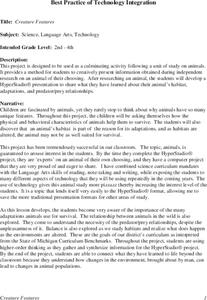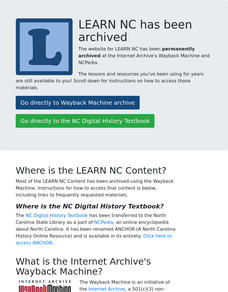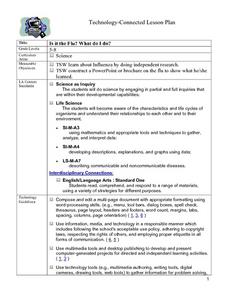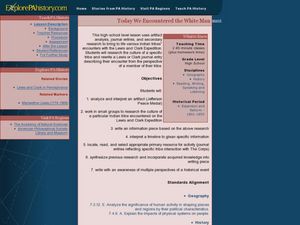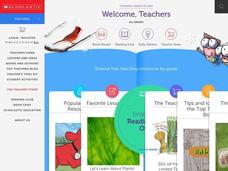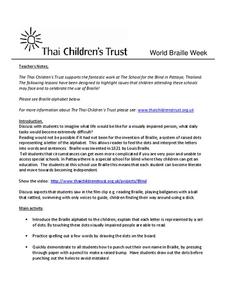Curated OER
What in the World..?!?
Students photograph mystery images. In this observation skills lesson, students gather everyday objects and place them under a digital microscope. They magnify the image and take a photograph of it. The image is then displayed on the...
Curated OER
Foods and Languages of the World
Students celebrate diversity. In this multicultural appreciation lesson, students celebrate diversity by sampling food from different cultures, learning a few words in Spanish and identifying the seven different continents.
Curated OER
Building a Nation
Students research the factors and events which lead to the creation of Canada. Using the internet, they participate in a "Confederation Review Conference" to discover how the country can best serve its citizens. They analyze current...
Curated OER
Mythopoly: Where in the World Is Odysseus?
Learners study Greek mythology. Among other activities, they evaluate a work of art and discuss the influence, significance, and history as it pertains to mythology. As a culminating activity they create a board game that shows their...
Curated OER
Creature Features
Students investigate animals and how they adapt to their environment. They design a multimedia presentation that includes information about an animal of their choice. They include a title card, habitats, adaptations, and a predator/ prey...
Curated OER
Juvenile Delinquency
Ninth graders analyze and interpret historical research by examining, analyzing, and forming opinions regarding primary resources. They compare/contrast social conflict, its causes and effects, in regards to continuity and change over time.
Curated OER
Al Capone Does My Shirts
Students are introduced to the novel "Al Capone Does My Shirts". Using primary source documents, they identify the unique geographical differences between where they live and the setting in the novel. They complete a Venn diagram...
Curated OER
Causes of the American Revolution
Students access websites for background information and learn how to interpret political cartoons. They incorporate higher-order thinking skills to determine if the information presented in the cartoons is accurate, what the colonists...
Curated OER
Asian, African, or Australian Inventors & Inventions
Seventh graders explore the inventors or inventions from Asia, Africa, and Australia.
Curated OER
Is It The Flu? What Do I Do?
Young scholars use the internet to research the flu. Using various websites, they identify who should get flu shots, how to protect themselves and guidelines for getting over the flu. They write a one page report on their findings to end...
Curated OER
Geometry and Quilting
Fourth graders combine geometry and language arts skills while examining quilt-making. After identifying the geometric shapes contained in quilts, they write stories to encompass the quilt border. Students conclude by creating and...
Curated OER
Fun On The Farm
Students experiment with a variety of resources to study about sounds and their sources (weather, animal, and transportation). They compare size, structure, and basic needs of living things. Each student studies about farm animals,...
Curated OER
Cargoes from Three Continents Ancient Mediterranean Trade
Sixth graders begin the activity by researching the different types of ships and shipbuilding techniques used to help trade in the Mediterranean Sea. Using different objects, they determine what one can tell about a society and discuss...
Curated OER
Today We Encountered the White Man
Learners analyze and interpret artifacts and a timeline to get specific information. In this timeline lesson plan students work in groups to research an Indian tribe and write an information piece of their research.
Curated OER
Design a Latin American Restaurant
Students investigate the culture of a Latin American country to design a new restaurant. In this Latin American lesson, students identify social classes, geographical locations, cultural practices, and monetary systems of a Latin...
Curated OER
Forensics 101
Students interpret how to communicate information and ideas in ways that are appropriate to the purpose and audience through spoken, written, and graphic means of expression. They use information-gathering techniques, analyze and...
Curated OER
Technology: Narrative Procedure Web Site
Young scholars use Web page templates to publish how-to instructions on the Internet. The Web sites are used as instructional databases for others to view. Students also participate in electronic message boards to post and answer...
Curated OER
Chicken Pox Math
Students will listen to a story of a boy with chicken pox and participate in a class discussion of chicken pox and what to do when you have a contagious disease. They will incorporate math by graphing who in the class has had the...
Curated OER
Heart Mobiles In Action
Students design a mobile or wall hanging that reviews the circulatory system. In this circulatory system lesson, students work in small groups to identify the structures of the heart, and create a model in the form of a two or three...
Curated OER
The First Thanksgiving
Students research the first Thanksgiving. In this first Thanksgiving lesson plan, students research the Internet about how the first Thanksgiving came about between the Native Americans and the Pilgrims. They complete a KWL chart, and...
Curated OER
Wars and Conflicts
Students explore the concepts of war and conflict. In this research skills lesson, students use Internet and print sources to research the causes, effects, main events, and significant figures of selected wars.
Curated OER
Thai Children's Trust
Young scholars spell words in braille and learn how to use braille to punch out their names. For this braille lesson plan, students discuss what life would be like for a visually impaired person.
Curated OER
Communication
Students identify good listening and talking skills and discuss verbal, written, and non-verbal communication. They create collages of magazine pictures demonstrating non-verbal communication.
Curated OER
CSAP Preparation: Don't Wait for the "Eleventh Hour"
Fifth graders participate in language arts activities designed to prepare them for taking standardized tests. The language arts format covers science and social studies content. Handouts and worksheets are included in the lesson.






